

Seniors run for the suburbs in their golden years.
The Fourth Industrial Revolution: what it means and how to respond. We stand on the brink of a technological revolution that will fundamentally alter the way we live, work, and relate to one another.
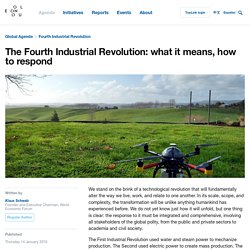
In its scale, scope, and complexity, the transformation will be unlike anything humankind has experienced before. We do not yet know just how it will unfold, but one thing is clear: the response to it must be integrated and comprehensive, involving all stakeholders of the global polity, from the public and private sectors to academia and civil society. Urban Scrawl: Poverty Moves to the Suburbs. North America is seeing a rising change in the distribution of wealth in its cities.
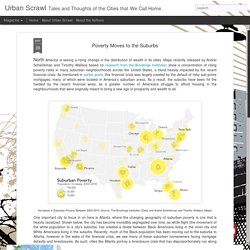
Maps recently released by Andrei Scheinkman and Timothy Wallace based on research from the Brookings Institution show a concentration of rising poverty rates in many suburban neighbourhoods across the United States, a trend heavily impacted by the recent financial crisis. As mentioned in earlier posts, this financial crisis was largely created by the default of risky sub-prime mortgages, many of which were located in America's suburban areas. As a result, the suburbs have been hit the hardest by the recent financial woes, as a greater number of Americans struggle to afford housing in the neighbourhoods that were originally meant to bring a new age of prosperity and wealth to all. One important city to focus in on here is Atlanta, where the changing geography of suburban poverty is one that is heavily racialized.
Poverty pockets growing in suburbs. By Noor JavedStaff Reporter Thu., Oct. 25, 2012 Behind the sprawling subdivisions and glossy condo towers being built in the GTA are the people who go unnoticed: The homeowner working two jobs to pay his mortgage, the single mother living in a basement apartment or the newcomer sharing a home with another family — or two But policy makers and charitable organizations stress that because the problem is invisible, doesn’t mean it is non-existent.
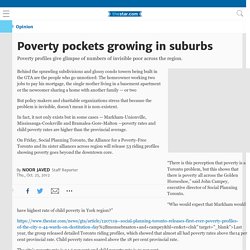
In fact, it not only exists but in some cases — Markham-Unionville, Mississauga-Cooksville and Bramalea-Gore-Malton —poverty rates and child poverty rates are higher than the provincial average. On Friday, Social Planning Toronto, the Alliance for a Poverty-Free Toronto and its sister alliances across region will release 53 riding profiles showing poverty goes beyond the downtown core. Naked approach. The Fourth Industrial Revolution: what it means and how to respond.
A flying drone taxi is provisionally cleared for takeoff. EHang, a Chinese company based in Guangzhou, has developed a drone capable of carrying the most dangerous game ... er, cargo: MAN!

The company is preparing to test the vehicle in Nevada. The helicopter, which uses a four-rotor design familiar to drone enthusiasts, is electric and can carry a single passenger and a small piece of luggage. Fully loaded, the company says the vehicle is capable of flying for 23 minutes at sea level or up to 63 miles an hour for 10 minutes a higher altitudes. That limits the range of the drone, which is called the Ehang 184, significantly, though it would be suitable for short hops where terrestrial passage is difficult or rescue missions, provided a victim's location is predetermined. In May the company announced a partnership with Lung Biotechnology to utilize the Ehang for organ transportation.
Vehicle automation: The missing piece in Canada’s green infrastructure puzzle. David Ticoll is Distinguished Senior Fellow in the Innovation Policy Lab at the Munk School of Global Affairs at the University of Toronto.
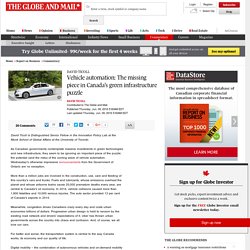
As Canadian governments contemplate massive investments in green technologies and new infrastructure, they seem to be ignoring an important piece of the puzzle: the potential (and the risks) of the coming wave of vehicle automation. Wednesday’s otherwise impressive announcements from the Government of Ontario are no exception. More than a million jobs are involved in the construction, use, care and feeding of this country’s cars and trucks. Fuels and lubricants, whose emissions overheat the planet and whose airborne toxins cause 20,000 premature deaths every year, are central to Canada’s oil economy. The 9-to-5 day could end for many feds as Metro repairs make flexible schedules the norm. Commuters wait on the platform at the Vienna/Fairfax Metro station in northern Virginia on Monday morning.
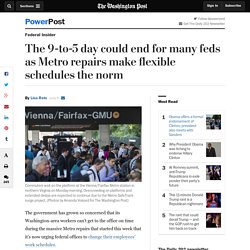
Overcrowding on platforms and extended delays are expected to continue due to the Metro SafeTrack surge project. (Photos by Amanda Voisard for The Washington Post) The government has grown so concerned that its Washington-area workers can’t get to the office on time during the massive Metro repairs that started this week that it’s now urging federal offices to change their employees’ work schedules. Soon Your City Will Know Everything About You. Libya is already a mess, but things may be about to take a serious turn for the worse.

Only a few months have passed since the United Nations helped Libyans to cobble together a unity government that was supposed to end the country’s two-year civil war. Yet now that faint hope of stability is threatening to vanish — and the result could be an even broader conflict, one that might even ultimately lead to partition. The reason is simple. Generation Uphill. SHEN XIANG LIVES in a shipping crate on a construction site in Shanghai which he shares with at least seven other young workers.
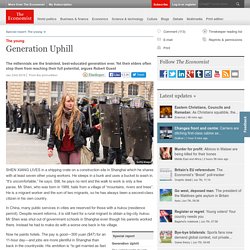
He sleeps in a bunk and uses a bucket to wash in. “It’s uncomfortable,” he says. Still, he pays no rent and the walk to work is only a few paces. Mr Shen, who was born in 1989, hails from a village of “mountains, rivers and trees”. He is a migrant worker and the son of two migrants, so he has always been a second-class citizen in his own country. Ethnographies of Future Infrastructures. By Laura Forlano, IIT Institute of Design Article 4 in the series Data, Design and Civics: Ethnographic Perspectives On April 1, Secretary of Defense Ashton Carter announced a $317 million federally funded initiative in textile innovation and manufacturing—a national consortium of public and private organizations to be led by MIT.

Recreation. Transit funding will drive Canadian cities into the future. By David Suzuki with contributions from David Suzuki Foundation Climate and Clean Energy Communications and Research Specialist Steve Kux Many people think of Canada as a landscape of forests, mountains, water and ice, but the Canadian experience is fast becoming focused on glass and concrete.
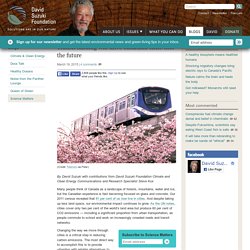
Our 2011 census revealed that 81 per cent of us now live in cities. And despite taking up less land space, our environmental impact continues to grow. As the UN notes, cities cover only two per cent of the world's land area but produce 60 per cent of CO2 emissions — including a significant proportion from urban transportation, as people commute to school and work on increasingly crowded roads and transit networks. Subscribe to Science Matters. Age-friendly environments. La Suisse pourrait créer un réseau de transport de marchandises souterrain. NCCAH > Hidden Assumptions in Mental Health. Colonial Norms as Determinants of Aboriginal Mental Health October 2012 – With Mental Illness Awareness Week and World Mental Health Day both falling in October, the timing is right for our new publication that explores both historical and ongoing mental health impacts of colonialism.
In Challenging Hidden Assumptions: Colonial Norms as Determinants of Aboriginal Mental Health, author Sarah Nelson outlines how colonial practices such as the residential school system and government banning of ceremonies inflicted a “soul wound,” or intergenerational trauma caused by the experience of systematic violence, oppression, and widespread grief, on Aboriginal peoples. Nelson demonstrates that historically, most mental health research involving Aboriginal peoples has been undertaken from a Western perspective, its lens tinted (and thus distorted) by colonialism. How soft robots will help sick kids and the elderly walk.
The SRI International campus is nestled on a quiet tree-lined Silicon Valley street, down the road from a high school and a seminary. The commuter train runs nearby. Its buildings are nondescript brick constructions that harken back to the 1970s. By all accounts, it’s a rather unimpressive place. But within its walls, scientists are building the future. SRI has been at the forefront of computer science, artificial intelligence and robotics since the 60s. Top Trends in Child Care - Child Care is Changing. Child care is evolving, and most care providers and parents agree the changes are for the best. What are some of the latest trends in child care and what should parents be looking for when making an all-important child care decision? Child Care Is Catering to Budget-Minded Families More parents are taking a careful look at child care costs, and decisions to reduce hours or even pull their kids out of organized programs entirely due to job losses or expenses are affecting child care providers as well.
As a result, more providers are offering flexible hours, keeping rates the same or even reducing them in some cases, and working out pay arrangements for struggling families to encourage families to stay. Special programs or fees are also being scrutinized as providers scramble to find ways to lessen costs while maintaining a quality care program for kids. New horizons for infrastructure investing.
Investors are having trouble finding attractive deals. They might be looking in the wrong places. The world needs new infrastructure—$57 trillion worth over the next 15 years, according to the McKinsey Global Institute. That’s an enormous sum, but as investors well know, there is no shortage of capital. Institutional investors are jumping in with both feet; indeed, infrastructure is now seen as an asset class in its own right. Limited partners and giant sovereign-wealth funds are putting money into play.